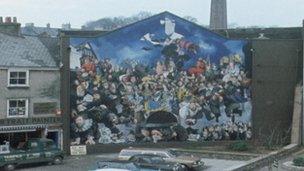Are we allowing great works of art to disintegrate?
- Published
Watch David Sillito visit Brian Barnes' mural in Brixton
From shopping centres and schools, to our greatest buildings, it is claimed many of Britain's best murals are being allowed to disintegrate.
The Twentieth Century Society is campaigning to save artwork from the post-war building boom.
"We are losing a whole chapter of our art history," says campaign director, Catherine Croft.
Ray Howard Jones's An Eye For The People located on the Western Mail building in Cardiff, has recently been destroyed.
So too has Barbara Jones's Adam Naming The Animals at Yewlands School in Sheffield.
Redevelopment and rebuilding has seen artworks across Britain reduced to rubble while others have just gradually faded.
"We are knocking down a lot of the buildings on which these buildings were originally painted - a lot were in schools and the Rebuilding Schools Programme has demolished some," Ms Croft says.
"A lot were in local authority buildings, publicly funded buildings and with the recession there isn't the money to keep them going - it's a really difficult time for murals."
Forgotten art
In the 1970s Robert Lenkiewicz's huge Elizabethan mural on the Barbican was a tourist attraction. Today you can barely see it.
Attempts are now being made to reawaken interest in our public art.
A conference on the topic has just taken place in London and an exhibition of the best of British mural art from 1920 to 1970 is currently on display at the Fine Art Society.

Robert Lenkiewicz's mural in Plymouth was visible in the 1970s but has now faded away
Many of the works are not mentioned in catalogues and some have been almost entirely forgotten.
In the Welsh seaside town of Colwyn Bay, the local council has just discovered the remains of murals on its derelict Victoria Pier.
They date from the 1930s, by the artists Eric Ravilious and Mary Adshead and have been covered in both wallpaper and a thin layer of plaster.
A bid is in with the Heritage Lottery Fund to restore both the pier and the murals.
Other works can be found on a shopping centre in Redditch, a tower block in Gosport and at Sunderland University.
'Great works'
One of the problems, campaigners say, is convincing people that art on shopping centres, schools and streets may be great works.
"We are just not taking them seriously enough," Ms Croft says. "They are really great works and they ought to be treated well, ideally kept in the buildings for which they were first created.
"But they are enormous and it's very difficult to find somewhere to put them where they wont get damaged."
Among the Twentieth Century Society's list of notable works is a mural on the Co-op in Ipswich, although the artist is a mystery.
In the post-war era mural art was taken very seriously.
Between the 1920s and the 1970s some of Britain's greatest artists were employed to create murals for buildings, streets and public spaces.
John Piper was given £1,200 (around £1.50 per sq-ft) in 1951 by the organisers of the Festival of Britain to created a 794 sq-ft painting.
The resulting piece - The Englishman's Home - was created in his garden using household paint and was seen by millions on the banks of the Thames in London.
- Published1 March 2013
- Published8 January 2013
- Published13 September 2012